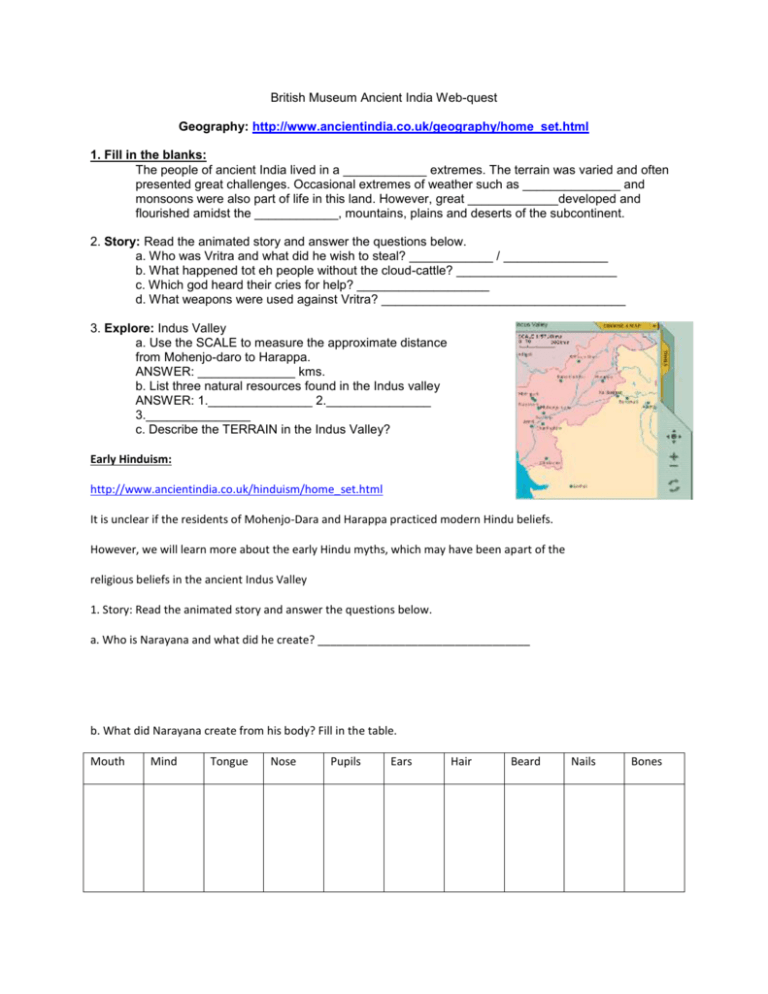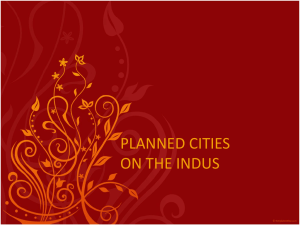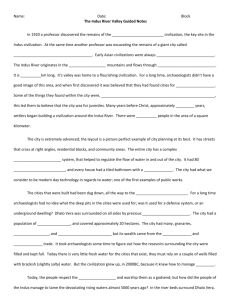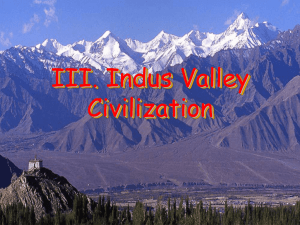Ancient Webquest - HRSBSTAFF Home Page
advertisement

British Museum Ancient India Web-quest Geography: http://www.ancientindia.co.uk/geography/home_set.html 1. Fill in the blanks: The people of ancient India lived in a ____________ extremes. The terrain was varied and often presented great challenges. Occasional extremes of weather such as ______________ and monsoons were also part of life in this land. However, great _____________developed and flourished amidst the ____________, mountains, plains and deserts of the subcontinent. 2. Story: Read the animated story and answer the questions below. a. Who was Vritra and what did he wish to steal? ____________ / _______________ b. What happened tot eh people without the cloud-cattle? _______________________ c. Which god heard their cries for help? ___________________ d. What weapons were used against Vritra? ___________________________________ 3. Explore: Indus Valley a. Use the SCALE to measure the approximate distance from Mohenjo-daro to Harappa. ANSWER: ______________ kms. b. List three natural resources found in the Indus valley ANSWER: 1._______________ 2._______________ 3._______________ c. Describe the TERRAIN in the Indus Valley? Early Hinduism: http://www.ancientindia.co.uk/hinduism/home_set.html It is unclear if the residents of Mohenjo-Dara and Harappa practiced modern Hindu beliefs. However, we will learn more about the early Hindu myths, which may have been apart of the religious beliefs in the ancient Indus Valley 1. Story: Read the animated story and answer the questions below. a. Who is Narayana and what did he create? __________________________________ b. What did Narayana create from his body? Fill in the table. Mouth Mind Tongue Nose Pupils Ears Hair Beard Nails Bones 2. Explore: Choose one Early Hindu God. Describe the god and explain WHY this god is your favorite? ________________________________________________________________________________ ________________________________________________________________________________ ________________________________________________________________________________ 3. Challenge: Learn more about Vishnu and his incarnations in this activity. Write a paragraph about what you learned about him. Indus Valley: http://www.ancientindia.co.uk/indus/home_set.html 1. Fill in the blanks: Around ____________ years ago, an important civilization developed on the Indus River _______________. From about 2600 B.C. to 1700 B.C. a vast number of____________ were built on the banks of the ________________ and surrounding areas. These settlements cover a remarkable region, almost 1.25 million kilometres of land which is today part of Afghanistan, _____________ and north-western India. 2. Answer the following questions: a. What were these early cites built of? _____________________________ b. What was “ sophisticated” about this early civilization? ________________________________________________________________ ________________________________________________________________ c. Why do we not know much about the lives of the people who lived in the Indus Valley? _____________________________________________________________ _____________________________________________________________ 4. Story: Read the fictional story about a boy living in about 2100 B.C. It was written based on the artifacts and remains found at an Indus Valley archeological site. Write a short 100 word SUMMARY of the story. _________________________________________________________ _________________________________________________________ _________________________________________________________ 3. Explore: Click on the Lower Town plan to explore these areas. Identify the following objects found in different areas of Mohenjo-daro and describe there use/purpose. CHART 4. Learn about the Lower Town http://www.ancientindia.co.uk/indus/explore/exp_set.html a. How was the lower town organized? ____________________________________________________________________ ____________________________________________________________________ ____________________________________________________________________ b. What were most of the homes made of? ____________________________________________________________________ ____________________________________________________________________ c. Describe a typical home in Mohenjo-daro. ____________________________________________________________________ ____________________________________________________________________ ____________________________________________________________________ ____________________________________________________________________ d. What evidence tells us that the people of Mohenjo-daro had access to clean water? ____________________________________________________________________ 5. Challenge: You are a young archaeologist working at a site which was once an Indus Valley city. Every day you are given boxes of pot sherds to sort through. Look through your pile of sherds and try to match them with known pottery types by reading the clues and looking at the profiles of the pots and sherds Time: http://www.ancientindia.co.uk/time/home_set.html 1. Fill in the blanks People have been living in the _____________ subcontinent for thousands of years, building some of the greatest civilizations in the world. Writing and __________ systems as well as __________ developed, some of which survive in one form or another to this day. Additionally, great works of art, architecture and ________demonstrate the richness of the enduring culture of this land. 2. Explore: Choose the Indus AND Writing timelines from the dropdown menu. In the time line below create your own an illustrated timeline of the period from 3100 BCE to 1700BCE. Writing: http://www.ancientindia.co.uk/writing/home_set.html 1. Fill inthe blanks The first Indian __________, developed in the Indus Valley around ________B.C. is still _______________. Thus, it is still not possible to fully _______________ this civilization, as we have no _____________________ of their beliefs, history, rulers or literature. 2. Explore the desk of this epigrapher who studies scripts used in ancient India. Answer the following questions. a. How many examples of Indus Valley script have been discovered? ______________ b. Where did Indus valley inscriptions appear ________________________________ c. In what direction was the Indus script written? ______________________________ d. Why is it difficult or impossible to work out the structure and meaning of these Indus scripts? _____________________________________________________________________________ ___________________________________________________ e. What types of materials have Indus script been found on? ________________________________________________________________ ________________________________________________________________ f. Describe what you see on the SEAL in a well developed paragraph. How were these seals made? g. complete the chart and write a paragraph (5 sentences) on the significance of the contents of the chart. Dates used Script 2600- 1700 b.c Languages century b.c to 3rd a.d Deciphered Left to right Right to left Yes Unknown Brahmi 4th Direction of Writing Sanskrit Gandhari Challenge: You are a young epigrapher studying the Indus script. The scholar you work with has gone away and left you with a partially completed sign list. Your job is to look at a fresh batch of Indus seals and add the signs on the seals to your list. You will need to decide whether each sign you 'take off' a seal is a new sign, or is the same as one which is already on the list.





![Indus[1] - ridgeaphistory](http://s3.studylib.net/store/data/006736077_1-c59280ecd30594bac8ab21ec7bce4db4-300x300.png)


